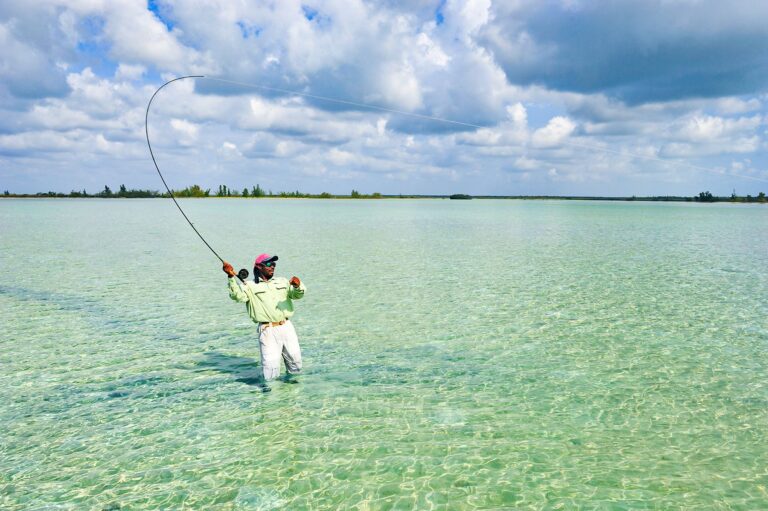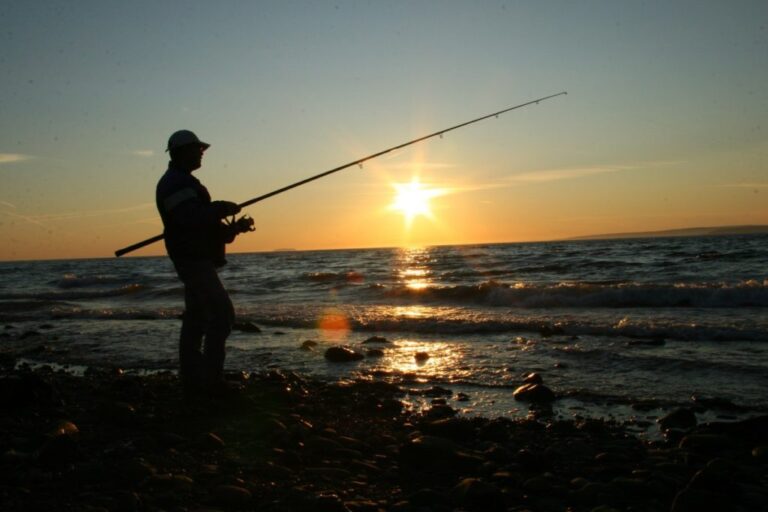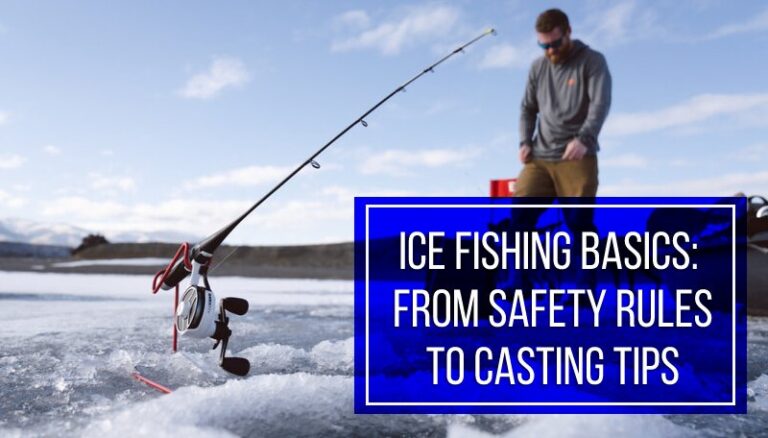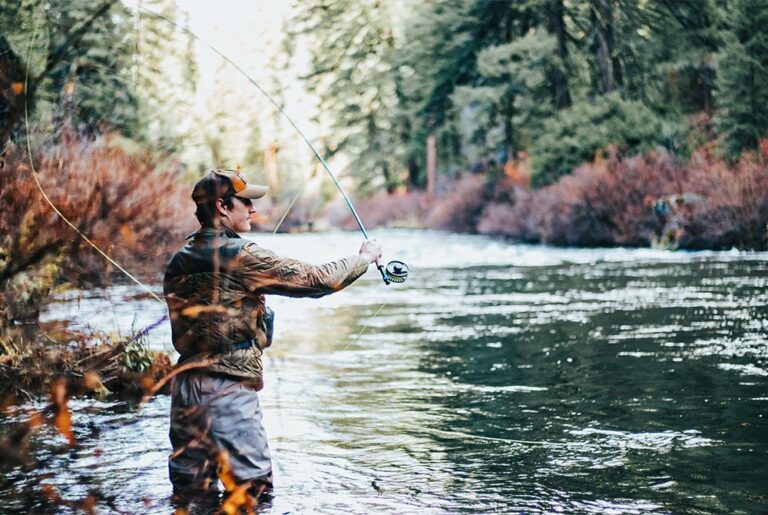Fly fishing on flats involves fishing for shallow water saltwater species, such as bonefish, permit, and tarpon, in clear water areas with a sandy or coral bottom. This fishing technique requires stealth, patience, and accuracy in casting.
Fly fishing on flats is one of the most exhilarating and challenging forms of angling. It involves stalking and casting to spooky, shallow-water game fish, such as bonefish, permit, and tarpon, in clear, shallow water areas with a sandy or coral bottom.
This type of fishing is unique in that it requires a high level of skill and technique, as well as knowledge of the target species’ feeding habits and habitat. To be successful, anglers must be stealthy, patient, and able to make accurate casts in difficult conditions. In this article, we’ll explore the world of fly fishing on flats, including the gear and techniques required to become a successful angler.

Credit: www.amazon.com
What Are Flats?
Fly fishing on flats is a popular activity that requires patience, skill, and knowledge. Flats are shallow areas of water that are located near the shorelines of oceans, seas, and freshwater bodies. They are great for fly fishing because they provide an ideal habitat for various species of fish, including bonefish, tarpon, and permit.
In this post, we will delve deep to understand the definition of flats and why they are excellent for fly fishing.
Definition Of Flats
Flats are shallow areas of water that are less than 30 feet deep. They are typically located near the shorelines of oceans, seas, bays, and estuaries. Flats can be muddy, sandy, or rocky, and they feature various types of vegetation, including seagrass, mangroves, and algae.
Flats are influenced by the tides, and their water levels can fluctuate as much as six feet in a day.
When it comes to fly fishing, flats offer a unique angling experience. Anglers can wade or pole the flats while sight-fishing for their target species. Flats fishing requires patience, stealth, and skill because fish on the flats can be challenging to catch due to their skittish nature.
Why Flats Are Great For Fly Fishing
There are several reasons why flats are excellent for fly fishing. Here are some of the key points:
- Flats provide clear water: Flats fishing requires clear water conditions so that anglers can sight-fish effectively. The shallow water on flats allows sunlight to penetrate to the bottom, which promotes the growth of seagrass and other vegetation. These plants filter the water and keep it clear, which makes fly fishing on flats a more enjoyable and challenging experience.
- Flats offer a diverse habitat: Flats are home to various species of fish, including bonefish, tarpon, permit, redfish, snook, and more. These fish are challenging to catch, and flats fishing requires a unique set of skills. Anglers must be patient, stealthy, and accurate in their presentations to catch fish on flats.
- Flats provide a sense of adventure: Flats fishing is a unique angling experience that offers a sense of adventure. Anglers must explore the flats by foot or boat while searching for fish. The unpredictable nature of flats fishing makes it exciting and challenging.
Flats are shallow areas of water that are located near shorelines of various water bodies. They offer clear water, a diverse habitat, and a sense of adventure, making them ideal for fly fishing. Understanding flats and their benefits is crucial for any angler who wants to enjoy the unique experience of flats fishing.
Essential Gear For Fly Fishing On Flats
Fly Fishing On Flats: Essential Gear For The Perfect Catch
Fishing on flats can be an exhilarating and challenging experience for many anglers. The crystal-clear water and bonefish, permit, and tarpon’s speed and agility demand specialized gear. If you’re planning to fly fish on flats, it’s essential to have the right gear.
Here are some crucial gear components for fly fishing on flats.
Rods, Reels, And Lines To Use And How To Choose Them
Choosing the right rod, reel, and line is critical for your success in fly fishing on flats. Here are some key points to consider when selecting the right equipment:
- Rods: For flats, a 9-foot, 8-weight rod with a fast action is ideal. It allows longer casts and handles larger fish. If you plan to go for smaller fish, you can choose a 7 or 8 weight rod.
- Reels: Flats fishing reels should have a large arbor and a smooth, strong drag. A sealed drag system reel is preferred to protect the equipment from corrosion due to saltwater.
- Lines: The line must match the rod and reel weights, with a weight-forward floating line being a popular choice. A high-performance, tropical line that won’t tangle or get stiff can make a significant difference.
Clothing And Accessories Necessary For Fly Fishing On Flats
Comfort and safety are the key factors when deciding what to wear for flats fishing. The right clothing and accessories can make your day more productive and prevent sunburn and injuries. Here are the key points to consider:
- Clothing: For flats fishing, wear light, breathable long-sleeved shirts and pants that dry quickly. Polarized sunglasses are crucial to reducing the glare on the water and spotting fish.
- Footwear: It’s essential to wear comfortable flats fishing boots that offer support and protection. Make sure they grip well on wet and slippery surfaces.
- Accessories: A hat or cap is essential for protecting your head and face from the sun. A good pair of gloves will protect your hands from sunburn and injury while handling fish. A stripping basket is useful to keep the line neat and prevent tangles.
Fly fishing on flats can be an unforgettable experience with the right equipment. Carefully selecting the right rods, reels, lines, clothing, and accessories is crucial. Keep in mind that your comfort and safety upon the water are significant, as well.
Follow these tips and you’re on your way to a successful and enjoyable fly fishing experience on the flats.
Fly Fishing Techniques On Flats
Fly fishing on flats requires specific techniques to land that perfect catch. From casting techniques to understanding tides and wind, there are crucial factors to consider when fly fishing on flats. Let’s explore some of the essential techniques to help you become a successful fly angler on flats.
Casting Techniques And Common Mistakes To Avoid
Casting is one of the most critical skills in fly fishing on flats. Here are some casting techniques to help you make accurate casts and avoid common mistakes:
- The sidearm cast is ideal for flats due to low wind resistance. Practice this cast to avoid spooking fish.
- The double-haul technique involves pulling your line back and forth to increase its speed and accuracy. It’s perfect for windy days on flats.
- Avoid stripping your line too hard, as it could spook fish. Use gentle strips to keep your fly moving naturally.
Understanding The Tides And Wind For Fly Fishing On Flats
Knowing the tides and wind patterns is essential in fly fishing on flats. Here are some things to consider:
- High tides are ideal for fly fishing, as fish come in close to shore to feed.
- Wind can make it challenging to fly fish on flats. Casting with the wind is easier than casting against it. Try to stay upwind of the fish and let the tide carry the fly to them.
Spotting And Approaching Fish
Spotting and approaching fish on flats requires skill and patience. Here are some tips to help you seek out fish:
- Look for nervous water, a sign that fish are feeding in that area.
- Pay attention to bird activity. Seabirds feeding on the surface could indicate fish below.
- Wear neutral colored clothing to avoid spooking fish.
- Approach fish slowly to avoid spooking them. Cast ahead of your target and retrieve your line slowly.
By following these essential techniques, you’ll set yourself up for success when fly fishing on flats. Happy fishing!
Fly Patterns For Flats Fishing
Fly fishing on flats is a unique experience that requires specific techniques and fly patterns to make the catch. If you’re new to flats fishing, you may be wondering what kind of fly patterns will give you the best chance of success.
In this section, we’ll discuss the best fly patterns and how to tie and rig them.
What Are The Best Fly Patterns To Use On Flats?
When it comes to flats fishing, the type of fly pattern you choose can make all the difference. Here are some of the best patterns to consider:
- Shrimp patterns – a popular choice for flats fishing due to the abundance of shrimp in the water. These patterns are typically tied with tan or pink-colored material.
- Crab patterns – another popular option, crabs are a common food source for many flats fish. These patterns are often tied with tan or brown-colored materials.
- Baitfish patterns – flats fish are known for their love of small baitfish. These patterns are often tied with white or silver materials to mimic the appearance of fleeing baitfish.
- Gotchas – this classic shrimp pattern is effective for catching species like bonefish and permit. These patterns are typically tied with tan or pink-colored material.
How To Tie And Rig Different Fly Patterns For Flats Fishing
Once you’ve selected the right fly pattern, it’s important to know how to tie and rig it properly. Here’s how:
- Shrimp patterns – tie a size 6-10 hook onto your leader and attach a bead chain or dumbbell eyes above it. Tie a layer of tan or pink chenille onto the hook shank, then add some rubber legs and a wing made of rabbit fur or synthetic material.
- Crab patterns – tie a size 4-8 hook onto your leader and attach dumbbell eyes to the top of the hook shank. Wrap tan or brown chenille around the hook shank, then add some rubber legs and a pair of claws made of rabbit fur or synthetic material.
- Baitfish patterns – tie a size 2-6 hook onto your leader and attach dumbbell eyes above it. Tie white or silver bucktail material onto the hook shank, then add a few strands of flash material and some rubber legs.
- Gotchas – tie a size 6-10 hook onto your leader and attach bead chain eyes above it. Tie a layer of tan or pink chenille onto the hook shank, then add rubber legs and a wing made of synthetic material.
By mastering these different fly patterns and techniques, you’ll increase your chances of success when fishing on flats. So next time you hit the water, don’t forget to pack these flies in your tackle box!
Reading Fish Behavior On Flats
Fly Fishing On Flats – Reading Fish Behavior On Flats
Fly fishing on flats is a great way to catch some of the most challenging fish species. But, in order to successfully catch fish on flats, you need to be able to read fish behavior. Understanding their feeding patters is key to catching them.
We will go through some of the things you need to look out for when reading fish behavior on flats.
How To Read And Interpret Fish Body Language
Fish use body language to communicate with other fish and their surroundings. You can learn a lot about what’s going on underwater by paying attention to their movements and posture. Here are some of the things to look for when interpreting fish body language:
- Tail movements: Fish often move their tail when feeding or searching for food.
- Fins: When a fish spots prey, their pectoral fins will move forward as they prepare to strike.
- Body posture: Fish that are actively feeding tend to have a more horizontal body posture, whereas those that are resting will have a more vertical posture.
What To Look For To Determine A Fish’S Feeding Patterns
Knowing a fish’s feeding patterns can help you increase your chances of catching them. Here are some things to look for to determine a fish’s feeding habits:
- Surface activity: If you see fish surfacing, it’s a good sign that they are actively feeding.
- Bird activity: Birds often feed on the same prey as fish, so if you see birds diving, there’s a good chance that fish are feeding below.
- Water movement: Look for areas where there is water movement, such as current breaks, as this can indicate areas of feeding activity.
Matching The Hatch
Matching the hatch means imitating the insects or other prey that fish are feeding on. It’s important to choose the right fly that mimics the prey because it increases the chances of a bite. Here are some tips on how to match the hatch:
- Observe what insects are hatching on the water.
- Check the size and color of the insects and try to match them with the appropriate fly.
- Be aware that fish can be selective feeders, so it’s essential to have a range of flies available.
Fly fishing on flats can be challenging, but by reading fish behavior and matching the hatch, you can increase your chances of catching them. Remember to pay attention to their movements and posture, and choose the right fly that mimics their prey.
Happy fishing!
Strategies For Difficult Situations
Fly Fishing On Flats: Strategies For Difficult Situations
Fly fishing on flats can be a great challenge, and there are times when you may find yourself in difficult situations where even experienced anglers have trouble. We will discuss three strategies that can help you in such situations.
How To Handle Tough Lighting And Conditions
Lighting and conditions can play a significant role in the success of your fly fishing trip, and sometimes, you may find yourself in tough situations. Here are a few ways you can handle them:
- Cloudy weather: In low light conditions, use brighter flies so that they are visible to the fish.
- Bright and sunny weather: During high light conditions, use smaller and darker flies that don’t reflect light, while also ensuring that you have polarized sunglasses that can help you see things under the water surface.
- Wind: Wind can be advantageous or disadvantageous, depending on how you manage it. If you are struggling to cast your line with the wind, try casting downwind or using heavier flies.
What To Do When The Fish Are Being Difficult
Sometimes, it can be challenging to get bites, even if you are in the right place. If this happens to you, use these tactics to help you get more bites:
- Try different flies: Change the color, size and pattern of the flies.
- Adjust the retrieve: Change the speed, rhythm or the technique to make it more attractive to the fish.
- Change the location: Sometimes moving to a different spot can be the trick to getting more bites, try focusing on the deeper areas or around structure.
Understanding The Importance Of Stealth When Fly Fishing On Flats
Stealth is one of the most critical aspects of fly fishing on flats since fish can spot you from a long distance. Here are a few ways to be more stealthy:
- Wear neutral-color clothing, hats, and shoes: Bright and flashy clothing can easily scare the fish away.
- Avoid making noise when wading: This can spook the fish and alert them to your presence.
- Avoid casting shadows: Cast from an angle where you can avoid casting a shadow over the fish you are targeting.
These strategies can help you overcome challenging situations when fly fishing on flats. Remember, there is always a solution to every problem, so be alert, creative and adaptive, and you will be sure to get more bites. Happy fishing!
Best Practices For Catch And Release
Fly fishing on flats is a thrilling experience that every angler should try at least once in their lifetime. It’s an exciting way to catch various species of fish in shallow waters, and it’s even more rewarding when you release them back into their natural habitat.
However, catching and releasing fish requires a certain level of expertise and know-how. In this section, we will be discussing the best practices for catch and release, including how to handle and release fish properly and the importance of fishing ethics and respect for nature.
How To Handle And Release Fish Properly
When it comes to handling and releasing fish, it’s crucial to ensure their safety and well-being. Here are some key points to keep in mind:
- Use barbless hooks: Barbless hooks are gentler on the fish and make it easier to release them.
- Keep the fish in the water: Whenever possible, keep the fish in the water while removing the hook. This reduces stress and the risk of injury to the fish.
- Use wet hands or a wet towel: Wetting your hands or using a wet towel will protect the fish’s slime coat, which is essential for their survival.
- Support the fish: Use both hands to support the fish when handling them. Never squeeze them or touch their gills.
- Don’t keep the fish out of water for too long: If you need to take a photo, make sure it’s a quick process. Fish can only survive out of water for a short period before they become exhausted and stressed.
Fishing Ethics And Respect For Nature
As anglers, we have a responsibility to behave ethically and respectfully towards nature. Here are some guidelines to follow:
- Follow regulations: Check the fishing regulations for the area you’re in and follow them accordingly.
- Catch and release: Consider catch and release as the first option when fishing. Only keep what you need, and release the rest.
- Don’t litter: Always dispose of your trash and fishing gear properly. Littering can harm wildlife and damage their habitat.
- Respect other anglers and their space: Give other anglers some space and don’t invade their fishing spot.
- Respect the fish: Treat the fish with respect, and release them gently. Remember, we’re just visitors in their environment.
Fly fishing on flats is an exciting way to catch fish, and catch and release practices are essential to ensure their survival. By following best practices and fishing ethically, we can preserve our natural resources for future generations to enjoy.
Resources For Further Learning And Practice
Fly fishing is no ordinary sport, and when it comes to flats fly fishing, it’s a whole different level. Flats fly fishing involves wading or poling in shallow waters to pursue bonefish, permit, tarpon, and other fish species. The feeling of standing in clear water surrounded by nature is something that every angler should experience.
We will help you take your flats fly fishing skills to the next level by providing you with relevant resources for further learning and practice.
The Best Books, Websites, And Communities To Learn From
Books
Fly fishing books are a great way to learn from experts and enhance your knowledge of the sport. Here are some of the best books on flats fly fishing:
- “bonefish fly patterns” by dick brown: This book is a must-read for anglers looking to perfect their bonefish fly patterns. It also includes information on equipment, tackle, and the proper techniques to catch bonefish.
- “fly fishing for bonefish” by chico fernández: Written by a cuban-born fly fishing professional, this book gives an in-depth look at the bonefish species and the best practices to catch them. The book also shares information on the necessary equipment and techniques to use.
Websites
The internet has a plethora of information on every topic, including fly fishing. Here are some of the best websites to visit for flats fly fishing:
- Gink and gasoline: This website is written by two experienced fly fishers and covers everything from gear to fly tying and casting techniques. It’s an excellent resource for flats fly-fishing.
- Hatch magazine: Offering a selection of informative articles that give valuable insights into the world of fly fishing, hatch magazine is a great resource for anglers of all skill levels.
Communities
- Fly fishing forums: Joining fly fishing forums such as fly fishing forum and hatch magazine community is an excellent way to connect with other anglers. You will have access to information on equipment, techniques, and recent developments in the sport.
Where To Practice And Hone Your Skills For Fly Fishing On Flats
Once you have learned the fundamentals of flats fly fishing, the next step is to practice and hone your skills. Here are some of the best places you can consider:
- Grass flats: Grass flats, found in the bays and estuaries of many coastal regions, provide an ideal location to practice catching fish in shallow water while honing your sight-fishing skills.
- Remote destinations: If you’re looking to further enhance your flats fly fishing skills, consider visiting remote fishing destinations such as the bahamas, belize, or mexico. These locations provide excellent opportunities to catch bonefish, tarpon, and permit in shallow, clear water.
Flats fly fishing is one of the most challenging but rewarding forms of angling. By reading the recommended books, visiting websites, joining communities, and practicing in the right locations, you’ll be well on your way to becoming an expert in this exciting sport.
Remember, the more you educate yourself and practice, the more successful you will be on the flats.
Conclusion
The fly fishing experience on flats is a combination of art, science, and patience. As we’ve discussed, you need to consider the tides, the weather, and the type of fish you’re targeting to make the most of your fishing trip.
Patience is key to success, but it’s not the only factor. You also need to perfect your casting technique, choose the right bait, and be ready to adapt to changing conditions. We hope this guide has helped you understand the basics of fly fishing on flats and given you some tips for your next fishing adventure.
Remember to respect the environment and the fish you catch, and always follow your local regulations. With practice and dedication, you could become a skilled fly fisherman and enjoy the thrill of catching a variety of fish on flats. Happy fishing!





